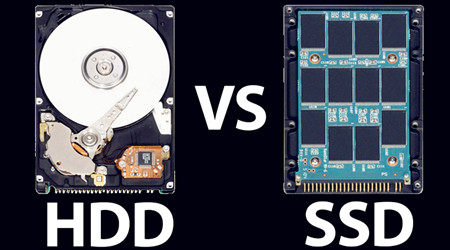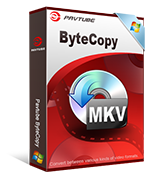Most people now buy laptops for their computing needs and have to make the decision between getting either a Solid State Drive (SSD) or Hard Disk Drive (HDD) as the storage component. You’re building or upgrading your PC, and you get to the business of storage. What should you go for? You can go for a Solid State Drive (SSD) or a more traditional Hard Disk Drive (HDD). There are merits to both, but what’s going to be best for your build, and your budget? Let’s break it down.

For the remainder of this article, we will make a full comparison of SSD and HDD storage and go over the good, the bad, and the ugly of both.
Part One: Choose the Right Storage
Part Two: Comparsion of SSD VS HDD
Part Three: Choose SSD & HDD as You Need
Part Four: Best Video Converter for SSD/HDD
Part Five: Convert Blu-ray, DVD, HD Movies on SSD/HDD
Part One: The Right Storage for You – From SSD or HDD
So, does an SSD or HDD (or a hybrid of the two) fit your needs? Let’s break it down:
HDDs
* Enthusiast multimedia users and heavy downloaders: Video collectors need space, and you can only get to 4TB of space cheaply with hard drives.
* Budget buyers: Ditto. Plenty of cheap space. SSDs are too expensive for $500 PC buyers.
* Graphic arts and engineering professionals: Video and photo editors wear out storage by overuse. Replacing a 1TB hard drive will be cheaper than replacing a 500GB SSD.
* General users: General users are a toss-up. Folks who prefer to download their media files locally will still need a hard drive with more capacity. But if you mostly stream your music and videos online, then buying a smaller SSD for the same money will give you a better experience.
SSDs
* Road warriors: People who shove their laptops into their bags indiscriminately will want the extra security of an SSD. That laptop may not be fully asleep when you violently shut it to catch your next flight. This also includes folks who work in the field, like utility workers and university researchers.
* Speed demons: If you need things done now, spend the extra bucks for quick boot-ups and app launches. Supplement with a storage SSD or hard drive if you need extra space (see below).
* Graphic arts and engineering professionals: Yes, I know I said they need hard drives, but the speed of an SSD may make the difference between completing two proposals for your client and completing five. These users are prime candidates for dual-drive systems (more on that below).
* Audio engineers and musicians: If you’re recording music, you don’t want the scratchy sound from a hard drive intruding. Go for quieter SSDs.
Part Two: SSD VS HDD Comparison
In its simplest form, an SSD is flash storage and has no moving parts whatsoever. As a result, they’re smaller and take up less space in a PC case, in some cases even mounting directly to the motherboard. SSD storage is much faster than its HDD equivalent. HDD storage is made up of magnetic tape and has mechanical parts inside. They’re larger than SSDs and much slower to read and write.
Now it’s time to do some comparisons and determine which might be best for your individual needs – SSD or HDD? The best way to compare items is a table with a side by side comparison of items in which a green box indicates an advantage:
| Attribute | SSD (Solid State Drive) | HDD (Hard Disk Drive) |
| Power Draw / Battery Life | More power draw, averages 6 – 7 watts and therefore uses more battery | |
| Cost | Expensive, roughly $0.20 per gigabyte (based on buying a 1TB drive) | |
| Capacity | Typically not larger than 1TB for notebook size drives; 4TB max for desktops | |
| Operating System Boot Time | Around 30-40 seconds average bootup time | |
| Noise | Audible clicks and spinning can be heard | |
| Vibration | The spinning of the platters can sometimes result in vibration | |
| Heat Produced | HDD doesn’t produce much heat, but it will have a measurable amount more heat than an SSD due to moving parts and higher power draw | |
| Failure Rate | Mean time between failure rate of 1.5 million hours | |
| File Copy / Write Speed | The range can be anywhere from 50 – 120MB / s | |
| Encryption | Full Disk Encryption (FDE) |
|
| File Opening Speed | Slower than SSD | |
| Magnetism Affected | Magnets can erase data |
Part Three: Some Rules For Choose Which Drive as You Need
If we tally up the checkmarks, the SSD gets 9 and HDD gets 3. Does that mean the that an SSD is three times better than an HDD? Not at all. As we mentioned earlier, it all depends on individual needs. The comparison here is just to lay out the pros and cons for both options. To aid you even more, here are some rules to follow when you decide which drive is best for you:
An HDD might be the right choice if:
- You need lots of storage capacity, up to 6TB (though with SMR technology new drives can have up to 10TB)
- Don’t want to spend much money
- Don’t care too much about how fast a computer boots up or opens programs – then get a hard drive (HDD).
An SSD might be the right choice if:
- You are willing to pay for faster performance
- Don’t mind limited storage capacity or can work around that
Hot Search: Copy Blu-ray to NAS | Store 300+ DVDs on Synology | Copy DVD to Hard Drive | Rip DVD to Computer Stick | Transfer DVDs to Boxee Box
Part Four: Best Video Converter for Store Blu-ray, DVD, HD Movies on SSD/HDD
Here, Pavtube Video Converter Ultimate (Mac) is perfect for you for the following reasons:
- Convert Blu-ray, DVD, AVI, MOV, MKV, MXF, TiVo, JPEG, BMP, etc to SSD/HDD accepted formats, like H.264/MP4. Read the review.
- Transcode AVI, MOV, MKV, MXF, TiVo, JPEG, BMPto iPad Pro, iPad mini 4, iPad Air 2, iPhone 7, iPhone SE, iPhone 6s, iPhone 6s Plus etc.
- Bypass copy and region protection from all commercial Blu-ray disc and even the newest one that are equipped with MKB61 and MKB62 encryption.
- Copy latest Blu-ray/DVD to SSD/HDD for streaming to Tablet, Phone, PS4, Xbox, TV, HD Media Player.
- Easily create an optimized file from this toolbox for main stream TV: Sony TV, Samsung TV, LG TV, Panasonic TV.
- Customize output files with provided practical video editing features, including: trim video length, crop video size, split large video into segments, add watermarks, adjust video effect.
- Optionally set video display ratio, bitrate, frame rate and other settings to obtain the best video and audio playback on your devices.
- Backup DVD to Dropbox, OneDrive, DLNA server, Google Drive, etc.
- Batch conversion and super 30X fast conversion speed.
- Supported OS: Windows 2003/XP/Vista/Windows 7/Windows 8/Windows 8.1/Windows 10
Free Download and Trail:
– Pavtube old official address: http://www.pavtube.cn/blu-ray-video-converter-ultimate/
– Cnet Download: http://download.cnet.com/Pavtube-Video-Converter-Ultimate/3000-2194_4-75938564.html
| Tips: Pavtube Video Converter Ultimate and other Windows Pavtube software has recently upgrade to version 4.9.1.0 with support for H.265/HEVC encoding acceleration on a PC that running Nvidia GPU with either Maxwell (GM206) or Pascal technology enabled graphic cards. |
Now follow the step-by-step guide to transcode your Blu-ray, DVD, HD Movies to SSD/HDD in a few clicks! For Mac OS Sierra steps also same, just make sure that you have download the right version.
Part Five: Steps On How to Convertting Blu-ray, DVD, HD Movies on SSD/HDD
|
Step 1: Insert your Blu-ray disc into your BD drive, run the best Blu-ray/DVD/HD Video to SSD/HDD Converter and click “BD/DVD disc” icon to load movie from DVD and Blu-ray source(Disc, folder, ISO). You can also click “Add Video” to load video files like MTS/M2TS, MKV, VOB, MOV, TOD, TiVo, etc. It supports batch conversion and joining multiple video clips into one file.
|
|
Step 2: Click the “Format” option, and choose HD Video > H.264 HD Video(*.mp4) or MKV HD Video(*.mkv) as output format.
|
|
Step 3: If you like, you can click “Settings” to change the video encoder, resolution, frame rate, etc. as you wish. Keep in mind the file size and video quality is based more on bitrate than resolution which means bitrate higher results in big file size, and lower visible quality loss, and vice versa.
|
|
Step 4: Start Video to SSD/HDD Conversion. Click the “Convert” icon under the preview window to start converting Blu-ray/DVD/HD Video to H.264/H.265 MP4 for SSD/HDD streaming. Once the conversion finished, you can click Open button to get the resulted videos effortlessly. Now it would be easy for you to stream Blu-ray/DVD/HD Videos through SSD/HDD to HDTV or other DLNA-compliant devices for great enjoyment.
|
Conclusion:
Which is Best? The best storage for you boils down to needs and preference in the debate between SSD vs. HDD. If you are on a budget, or are planning on using your laptop for basic essential student needs, like typing up documents and browsing the web, an HDD will be the best option. It offers plenty of space at a cheap price for when you need it. If you need speed and performance and have a bigger budget, an SSD is the way to go. There’s no straight-forward answer to this question; each buyer has different needs and you have to evaluate the decision based on those needs, your preferences, and of course budget. In the end, No matter which you choose, you need this powerful SSD/HDD Video Converter for better storage.
Read More:









